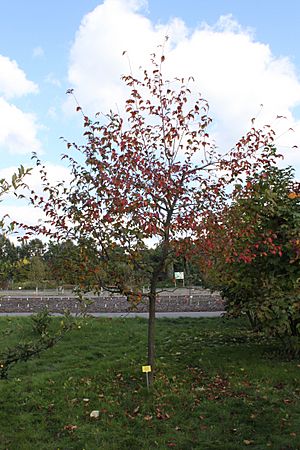× Amelasorbus facts for kids
Quick facts for kids × Amelasorbus |
|
|---|---|
 |
|
| Here labeled as × Amelasorbus raciborskiana | |
| Scientific classification | |
| Genus: |
× Amelasorbus
|
| Species: |
jackii
|
× Amelasorbus is a special type of flowering plant in the Rosaceae family, which includes roses and apple trees. It's a natural hybrid, meaning it's a mix of two different kinds of trees. This plant comes from a cross between trees from the Amelanchier genus and the Sorbus genus. It looks a bit like both of its parent plants.
This kind of hybrid, where two different genera (groups of plants) cross, is quite rare. The "×" symbol before its name shows that it's a hybrid. The name Amelasorbus is a portmanteau word. This means it's a new word made by combining parts of the names of its two parent groups: Amelanchier and Sorbus.
Contents
What is × Amelasorbus?
The "×" symbol in front of Amelasorbus tells us it's a hybrid plant. A hybrid is like a mix of two different species or, in this case, two different plant groups (genera). It gets traits from both its "parents."
How Hybrids Form Naturally
Sometimes, two different types of plants can cross-pollinate in nature. This means pollen from one plant lands on another, and they create a new plant that has features of both. This is how natural hybrids like Amelasorbus are formed.
The Only Known Species: × Amelasorbus jackii
There is only one officially recognized species of Amelasorbus, called × Amelasorbus jackii. It is also known as Jack's amelasorbus. This plant is a mix of Amelanchier alnifolia (also known as Saskatoon berry or serviceberry) and Sorbus scopulina (a type of mountain-ash).
Discovery and Location
A specimen of × Amelasorbus jackii was first found growing in Idaho in the United States. It was described in 1925 by Alfred Rehder, a scientist from the Arnold Arboretum. Other plants of this type have also been found in Oregon.
Why Hybrids Can Look Different
Because × Amelasorbus jackii is a hybrid, individual plants can look quite different from each other. This natural variation sometimes made scientists think they were finding new species. For example, × Amelasorbus raciborskiana and × Amelasorbus hoseri were once thought to be separate species. However, they might just be different forms of × Amelasorbus jackii.
See also
 In Spanish: ×Amelasorbus para niños
In Spanish: ×Amelasorbus para niños

